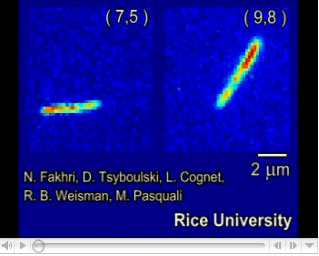| Posted: August 31, 2009 |
Rice team defines nanotubes' flexing characteristics 'once and for all' |
|
(Nanowerk News) The wiggling rainbows are pretty to look at, and what they represent is certainly intriguing.
|
|
Rice scientists have created a video of bending and flexing carbon nanotubes to show once-undetectable characteristics that may someday be tuned for medical and industrial use.
|
|
A paper by Rice researchers and a French colleague in this month's Proceedings of the National Academy of Sciences ("Diameter-dependent bending dynamics of single-walled carbon nanotubes in liquids") describes their work to understand the Brownian bending dynamics of single-walled carbon nanotubes in water. The researchers provide a formula to determine the bending properties of a nanotube on the basis of its length and diameter.
|
 |
|
Brownian motion is the apparently random movement of particles suspended in a fluid, a process observed for centuries but first detailed in 1827 by Scottish botanist Robert Brown, who noticed jittering particles in grains of pollen and decided to investigate.
|
|
Now researchers can see nanotubes do the same dance. Three years ago, Matteo Pasquali, a Rice professor in chemical and biomolecular engineering and in chemistry, twigged the wiggling when he used standard microscopes and video cameras to film nanotubes moving in a fluid. But what his camera really saw was the motion of a fluorescent dye that surrounded the tubes.
|
|
Pasquali wanted a way to see the tubes themselves, and that required a meeting of the minds. Bruce Weisman, a Rice professor of chemistry, had discovered in 2002 (in a project with late Rice Nobel laureate Richard Smalley) that single-walled carbon nanotubes are themselves fluorescent -- that is, they absorb one wavelength of light and give off another.
|
|
Capturing that aura-like glow has become a specialty of Weisman's photophysics research lab. "His technique detects directly the light emitted by the nanotubes," Pasquali said. "
|
|
"We realized a few years ago that the technology we have for imaging is well-matched to Matteo's interest in the bending properties and stiffness of these tubes," said Weisman.
|
|
He said the recently developed ability to see emissions in the near-infrared range let researchers view more than motion. The fluorescent signature also told them precisely what diameter of carbon nanotube they were looking at.
|
|
It turns out the bending characteristics of material scale well. Short, wide carbon nanotubes bend only a little or not at all, according to the formula that states stiffness scales as the cube of the nanotube's diameter. A long, wobbly PVC pipe used in plumbing, cut into small pieces, will behave the same way -- that is, as the ratio between width and length decreases, the stiffness increases.
|
|
Weisman called the results "not too surprising."
|
|
"It's basically an extension of macroscopic mechanical behavior down to the nano scale," he said. In fact, Boris Yakobson, a Rice professor in mechanical engineering and materials science and of chemistry, had predicted this behavior about a decade ago, Pasquali said.
|
|
He said the study of the bending properties of continuous macroscopic beams dates back to at least 1638, when his countryman Galileo Galilei published the “Discourses and Mathematical Demonstrations Relating to Two New Sciences.” Swiss physicist Leonhard Euler refined that work into continuum mechanics about a century later. Pasquali said Euler's calculations are now known to govern beams only one atom thick and whose diameter is one billion times smaller than the beams in Galileo’s drawings.
|
|
|
|
"Now it's measured once and for all," said Pasquali. Anyone concerned about the processing and dispersion of nanotubes, as well as how they move in constrained environments, will be interested in the study, he said. Nanotubes also fall into line with the semiflexible filament model that had been developed to describe the motion of such biological threads as actin and microtubules.
|
|
"We don't know for sure, but it's possible the normal stiffness (of a nanotube) affects biological function," he said. "Now that we've measured this, one may be able to assess whether the stiffness of the tubes has any effect on the way they interact, for example, with cells." He said studies can take into account the stiffness of a nanotube when assessing its potential toxicity.
|
|
Nikta Fakhri, a graduate student in Pasquali's lab and primary author of the paper, said quantifying the tubes' Brownian motion in water leads to more possibilities. "Now we can put nanotubes into other media to see how they behave," she said. "That means you can use them as probes to sense their environment."
|
|
Weisman said the technique only works with single-walled, semiconducting nanotubes, as multiwalled tubes do not naturally fluoresce.
|
|
The paper authored by Pasquali, Weisman, Fakhri, Rice postdoctoral researcher Dmitri Tsyboulski and Laurent Cognet of the University of Bordeaux will provide guidance for further studies, Weisman said. "It doesn't immediately solve some problem that's sitting there begging to be answered," he said, "but it's an important contribution to nanotechnology research and development."
|
|
And, he admitted, the images are cool. "The video is immensely popular," he said. "I often think I can give an entire seminar just looping this thing for 50 minutes and everybody would be as happy as can be. Everyone in the audience just sits there entranced."
|

